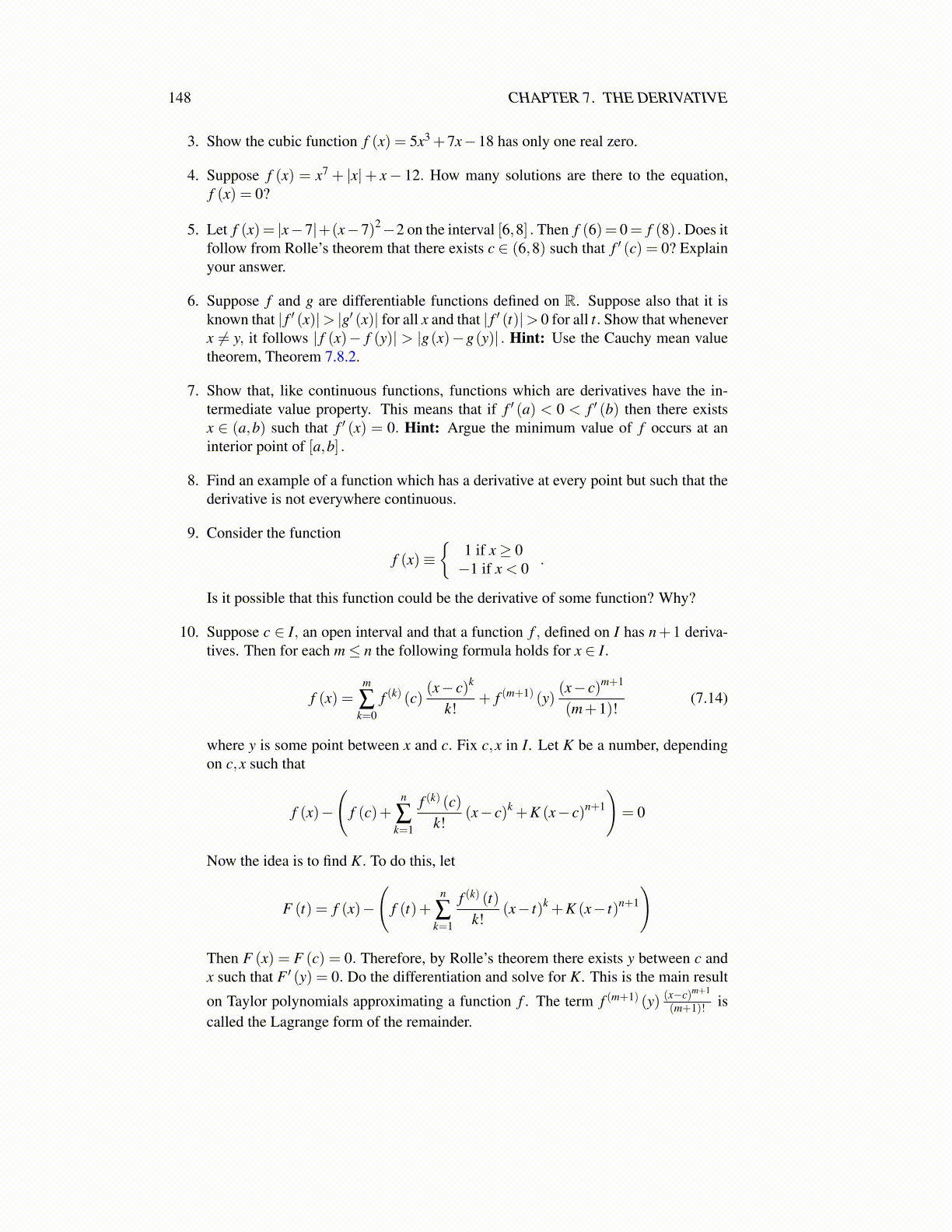
148 CHAPTER 7. THE DERIVATIVE
Theorem 7.10.1 Let f : [a,b]→ R be continuous and one to one. Suppose f ′ (x1)
exists for some x1 ∈ [a,b] and f ′ (x1) ̸= 0. Then(
f−1)′( f (x1)) exists and is given by the
formula,(
f−1)′( f (x1)) =
1f ′(x1)
.
Proof: As above, Lemma 6.4.3, f is either strictly increasing or strictly decreasing on[a,b] and f−1 is continuous. Always y will be in the interval f ([a,b]) if x1 is at an endpoint. Then, from assumption that f ′ (x1) exists,
|y− f (x1)|=∣∣ f ( f−1 (y)
)− f (x1)
∣∣= ∣∣ f ′ (x1)(
f−1 (y)− x1)+o(
f−1 (y)− x1)∣∣
by continuity, if |y− f (x1)| is small enough, then∣∣ f−1 (y)− x1
∣∣ is small enough that
∣∣o( f−1 (y)− x1)∣∣< | f ′ (x1)|
2
∣∣ f−1 (y)− x1∣∣ .
Hence, if |y− f (x1)| is sufficiently small, then from the triangle inequality of the form|p−q| ≥ ||p|− |q|| ,
|y− f (x1)| ≥∣∣ f ′ (x1)
∣∣ ∣∣ f−1 (y)− x1∣∣− | f ′ (x1)|
2
∣∣ f−1 (y)− x1∣∣
=| f ′ (x1)|
2
∣∣ f−1 (y)− x1∣∣
It follows that for |y− f (x1)| small enough,∣∣∣∣∣o(
f−1 (y)− x1)
y− f (x1)
∣∣∣∣∣≤∣∣∣∣∣o(
f−1 (y)− x1)
f−1 (y)− x1
∣∣∣∣∣ 2| f ′ (x1)|
Then, using continuity of the inverse function again, it follows that if |y− f (x1)| is possiblystill smaller, then f−1 (y)−x1 is sufficiently small that the right side of the above inequalityis no larger than ε . Since ε is arbitrary, it follows
o(
f−1 (y)− x1)= o(y− f (x1))
Now from differentiability of f at x1,
y− f (x1) = f(
f−1 (y))− f (x1) = f ′ (x1)
(f−1 (y)− x1
)+o(
f−1 (y)− x1)
= f ′ (x1)(
f−1 (y)− x1)+o(y− f (x1))
= f ′ (x1)(
f−1 (y)− f−1 ( f (x1)))+o(y− f (x1))
Therefore,
f−1 (y)− f−1 ( f (x1)) =1
f ′ (x1)(y− f (x1))+o(y− f (x1))
From the definition of the derivative, this shows that(
f−1)′( f (x1)) =
1f ′(x1)
.The following obvious corollary comes from the above by not bothering with end
points. In this case, we can also consider the case where f is defined on an open set inF and has values in F where F is either R or C. The new feature is that it might not makesense to consider one sided derivatives if F= C.